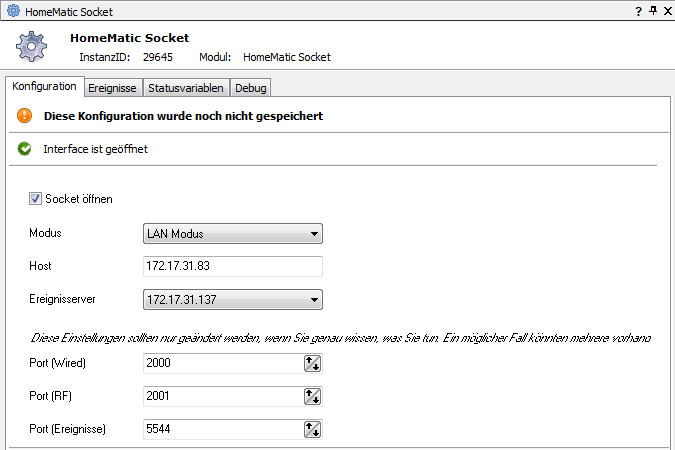Documentation
BidCos Service
The BidCos service is an alternative to the CCU-supported control of HomeMatic devices.
Configuration of the LAN-adapter
First of all, the latest user software must be installed from the HomeMatic site.
We recommend assigning a fixed IP-address (DHCP: Off):

After successful installation a new directory was created: "x:\ProgramData\Bidcos-Service\"
The serial number (see label) and the IP address of the adapter must be adjusted in the 'bidcos.conf' file.
Example:
[Interface 0]
Type = Lan Interface
Serial Number = GEQ0123456
Key is on the back of the interface.
The function can also be deactivated via the LAN tool.
Then the field can be left blank
Encryption Key =
Description = First Lan Interface
IP address of the LAN interface
IP Address = 192.168.2.61

Further settings in bidcos.conf are not required.
It is essential that the following entry remains unchanged:
TCP Port for XmlRpc connections
Listen Port = 2001
Testing the adapter
A successful configuration can now be checked with the "Test-Run BidCos-Service" program. The last line in the DOS window then reads: "… Connected to Lan Interface…".

A flashing power LED indicates that the BidCos service is not connected.
If necessary, the start options can be adjusted (Control Panel > Administration > Services) or the service can be started manually:

Configure HomeMatic-Components
In the "HomeMatic Configurator" program, the connection "Remote BidCoS Service" must be selected under "File > Settings". Then the IP address (localhost) and the port (2001) have to be entered.
Finally, the HomeMatic components can now be added one after the other in the "Teach-in devices" menu.
Client Socket in IP-Symcon
The HomeMatic Socket (in the I/O instances) must be configured. "LAN Mode" must be selected as the mode. If the BidCoS service is running on another PC, its IP address must be entered as the host. Otherwise "localhost" must remain specified as the address. If there are several network adapters, the IP address of the network-adapter, which the LAN-adapter is connected to, must be selected in the event-server. The port (5544) does not have to be changed, it only has to be enabled in an existing firewall.
